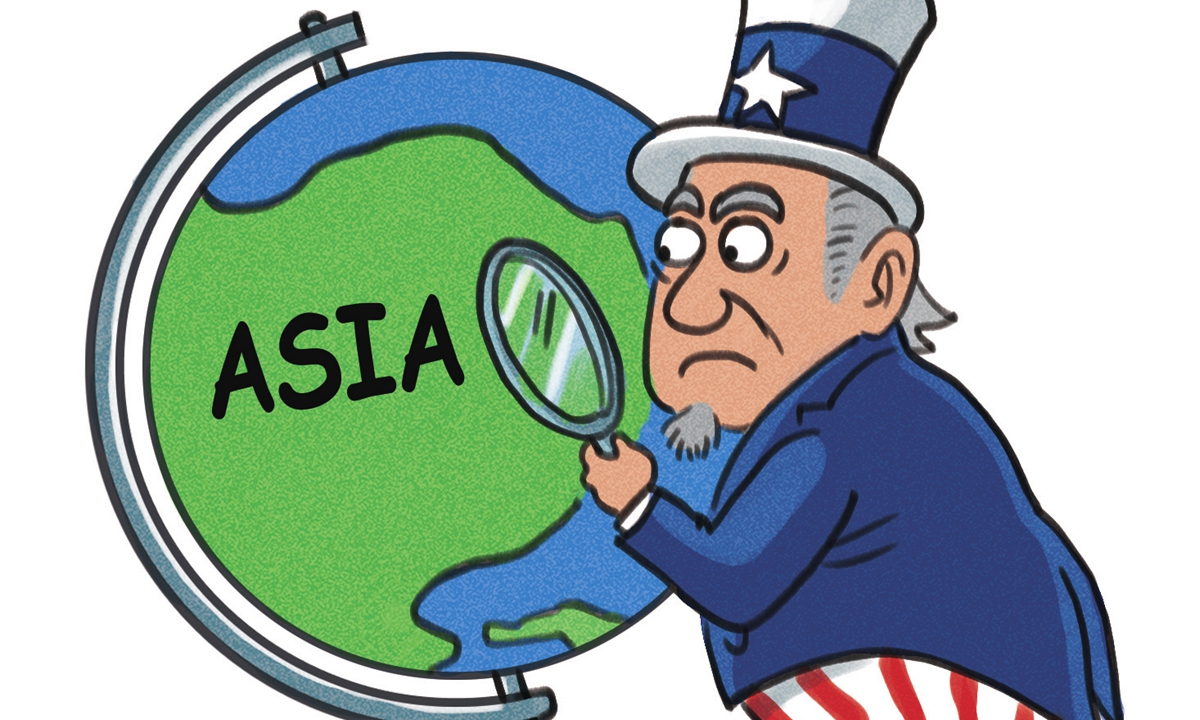Can enfeebled Washington still dominate Asia's configuration?
By Ling Shengli Source: Global Times Published: 2020/11/24 17:13:41

Illustration: Liu Rui/GT
The US has long wielded enormous influence in Asia since it entered the Philippines through the Spanish-American War 122 years ago in 1898. Now, we must ask: Has its influence in the region decreased as its own power declines? What will happen to the regional architecture in Asia as America weakens? For the Biden administration, maintaining US hegemony remains the primary goal of its global strategy. This will ensure that US influence in Asia does not decline rapidly — which is of critical importance for Biden team.For the US to achieve such goals will not only depend on its own power, but also its relations with allies and partners in the region. This also involves its influence and authority with regional institutions.
The strategic resource for US dominance in the Asia-Pacific region comes first from its own power. Economic power, in particular, is the fundamental source to support its foreign strategy. It also, to a large extent, determines the US government budget—especially the defense budget. The economy in the US has been severely hit by the pandemic, and it is uncertain whether it can maintain its strategic investment in Asia for some time to come. In addition, global strategic layout of the US will also affect its strategic resources in Asia. In global strategic layout of the US, there is a certain correlation between Asia and Europe as the country faces dilemmas stabilizing the West and moving into the East.
Moreover, partnerships with Asia-Pacific allies are also important resources for the US. Under the Obama administration, the US tapped its "stock" of resources in the region, by strengthening ties with traditional allies and making "incremental" efforts to expand partnerships with others. The US has tried its best to coordinate all kinds of resources to compete with China in the region. By increasing its strategic resources, it can offset elements of its relative decline.
It also intends to isolate China or restrict the expansion of China's influence in Asia. However, relatively speaking, uncertainties exist about how US' partnerships with its Asia-Pacific allies will support its regional strategy. The uncertainty depends on the allies' own strength and their relations.
Also, US can affect institutions in Asia. The international system is characterized by "non-neutrality." Great powers tend to dominate and exploit the international institutions to serve their own national interests. Different from other prior hegemonic countries, US dominance is also called institutional hegemony. Control over international institutions has become a crucial pillar of US hegemony, and Asia is no exception. The incoming Biden administration is expected to return to multilaterialism, attaching more importance to international institutions. In general, US' impact on Asian regional institutions is most prominent in the domain of security, but relatively weaker in terms of politics and economics.
Lastly, the US has established its authority in the region. Different from coercion, the ability to build authority over other countries rests on others' willingness rather than on persuasion or debate. After years' of attempts, Washington has established and accumulated some authority in the Asia-Pacific region. Therefore, the US sometimes does not need to resort to its hard power to affect regional affairs, as it can be achieved merely by its authority. As a result, the US' relative decline has not significantly undermined its regional leadership. Even if its hard power continues to fall in the future, the US can still exert its influence by virtue of its long-standing authority in the Asia-Pacific region.
China, the US, Japan, Russia, India and ASEAN are the main six forces that are influencing the configuration of power in Asia. China as a major regional country has enjoyed a geographical, historical and cultural edge here. With China's growing national strength and influence, it has played a greater role in shaping regional architecture and order. Japan also pays great attention to its own influence in the Asia-Pacific region. Japan has a strong desire to seek Asian dominance driven by its pursuit to become a major country. For Russia, although Asia is not its strategic focus, Moscow is not willing to only be an onlooker given the increasing global strategic importance of Asia. Therefore, Russia has also been increasing its strategic input in Asia over the past few years.
Because of the implementation of India's Act East policy and US' Indo-Pacific Strategy, India's influence in Asia has also increased. In addition to the five powers, ASEAN also plays a crucial role in the Asia-Pacific region. As a coalition of small and medium-sized countries, ASEAN's leading role in regional cooperation is very obvious. It has become one of the most important forces that have remodeled the Asia-Pacific region over the past 20 years.
In conclusion, though the US is only on the edge of the Asia-Pacific region, it influences the regional configuration through multiple ways, including strengthening its alliances and expanding partnerships. It is conceivable that America will become relatively enfeebled in the future from internal disharmony. But its dominance over Asia is not going to wane any time soon. Nonetheless, America may find it more and more difficult to take charge of Asia. Looking ahead, Asia is more likely to enter a multi-polar era rather than a bipolar system of confrontation between China and the US — let alone a unipolar system in which China replaces America.
The author is secretary-general of the International Security Study Center at China Foreign Affairs University. opinion@globaltimes.com.cn
Posted in: VIEWPOINT,ASIAN REVIEW,CHINA-US